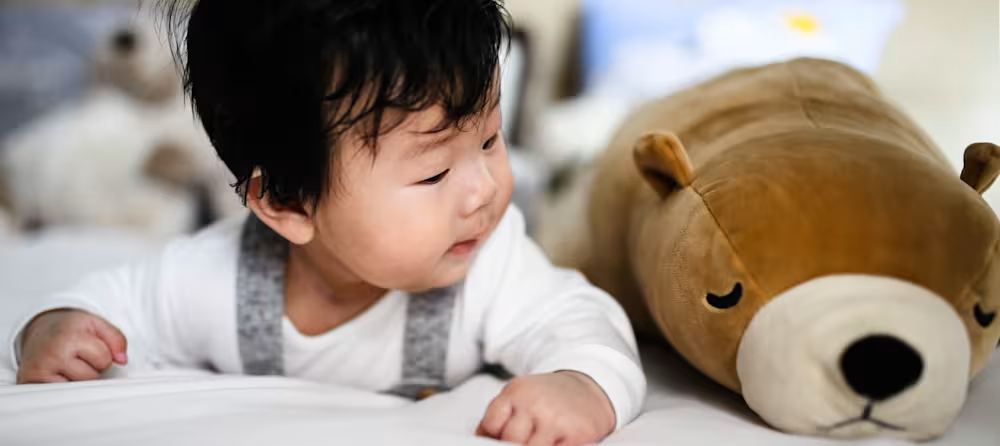4 month sleep regression: Why it happens and what you can do about it

Updated Feb 07, 2023
Babies often see a big change in their sleep habits around 3 - 4 months old. Just as your baby leaves the newborn stage and their sleep patterns start to become more predictable — bam! — you may see a big shift. Sudden increases in night waking, short naps, fussiness, or fighting sleep? Yup, the 4 month sleep regression is probably to blame.
But not to worry — whether you’re dreading your baby’s first sleep regression or are already in the midst of it, we’re here to help guide you through this important developmental milestone.
IN THIS ARTICLE:
What is the 4 month sleep regression?
When babies are around 3 - 4 months old, their sleep patterns start to mature. Rather than continuing to sleep as a newborn, they now have additional cycles of light sleep and deep sleep.
Why do babies have a 4 month sleep regression?
It’s important to note that at this stage, changes in sleep are caused by a biological alteration in the way a child sleeps, rather than a regression caused by a temporary state. To put it simply, your baby may be waking more because they’re growing and developing — not because they’re going backward.
Despite this first big developmental growth spurt, don't pack up the pacifier and send them off to college just yet. The so-called sleep “regression” happens because your baby starts to wake fully between these cycles and needs help falling back to sleep.
Developmental changes at 3 - 4 months
By this age, babies have begun to produce their own melatonin, the hormone that helps to regulate our sleep-wake cycle. (Note that breastfed infants also via their mother’s milk.)
While a newborn’s sleep isn’t strongly controlled by circadian rhythm (our internal “body clock” that helps control sleep), that all starts to change at this age. Sleep begins to mature, and babies start sleeping in more stages and cycles, similar to the sleep patterns of an adult.
Once a baby starts to cycle through light and deep sleep, they’ll have a brief period of wakening after each cycle. While this period of wakefulness can lead to new sleep challenges (we’ll get to that in a second!), it’s actually a pretty cool built-in protective mechanism that allows the body to check in on its environment, making sure everything is safe and sound throughout the night.
Note that for children who were born early, we go by their adjusted age for sleep development. So, the 4 month sleep regression signs may appear later for a premature baby and that's totally normal.
So, what happens during the 4 month sleep regression?
It’s those brief awake periods that can cause a lot of disruptions to sleep and lead to the dreaded 4 month regression.
This is how it typically plays out: Your baby falls asleep in your arms or a swing/bouncer, then is moved to the crib. Later, when they wake up in between sleep cycles and their environment is different from the way they fell asleep, this causes them to wake fully (rather than fall back to sleep on their own and shift onto the next sleep cycle).
Once fully awake, they often want some help from you so they can get back to sleep. Another cuddle sounds way better than closing their eyes and doing it themselves, especially if they haven’t practiced the skill of falling asleep on their own. Needless to say, it can be extremely disruptive to a family’s sleep if that happens repeatedly throughout the night.
Think of it this way — you fall asleep with a pillow, but when you wake up during the night, it’s mysteriously vanished. You’d want that pillow back and might have a hard time returning to sleep without it. However, if your pillow had remained under your head, you’d be able to just roll over and fall back to sleep.

How long does the 4 month sleep regression last?
Sleep regressions typically last 2 - 6 weeks. Improving sleep after the 4 month regression depends on how quickly a baby is able to develop healthy sleep habits and be physiologically ready to link sleep cycles on their own.
When does it start?
The 4 month regression begins around 3 - 4 months of age when a baby begins to cycle between light sleep and deep sleep, similar to an adult, rather than the more constant state of sleep of a newborn. (Newborns tend to sleep in two sleep stages, compared to the four sleep stages of sleep after 4 months of age.) This maturation in sleep can suddenly lead to multiple wakings at night and short naps, although it doesn't significantly disrupt sleep for all babies.
When does it end?
Babies typically start sleeping better when they follow an age-appropriate schedule, are developmentally able to link sleep cycles, and learn how to fall asleep independently. With the right guidance, most babies are able to master falling asleep on their own by 5 - 6 months old, if not sooner.
Does the 4 month sleep regression affect naps?
One of the unfortunate 4 month sleep regression symptoms is that your baby may take shorter naps. Babies often wake after 30 - 45 minutes of sleep and are unable to fall back to sleep without help.
8 tips to overcome the 4 month old sleep regression
Since sleep is critical for brain development and overall health, we don’t want anyone missing out on sleep if they don’t have to. Whether you’ve started to notice sleep changes or not, here’s what you can do to make the transition smooth:
1. Establish a consistent bedtime routine.
Consistent pre-bedtime and pre-nap routines are an effective way to let your baby know what to expect at sleep times. A calm, predictable routine can also help relax your baby and prime them for sleep. A bedtime routine might look like this: breastmilk or formula feeding, a bath/wash up, change into a dry diaper and pajamas, and read a story before bed. When the same set of activities is done in the same order each time, children can predict what comes next, which adds to their sense of security. This can make the transition to sleep much easier.
2. Encourage baby to fall asleep in their sleep space.
One of the best ways to prevent babies from waking frequently at night is to help them learn to fall asleep at bedtime under the same conditions they’ll experience for the rest of the night. If your goal is for baby to spend most of the night in their crib, give them some practice falling asleep there. If they tend to fall asleep in your arms (or another sleep surface), you’ll want to give them the time and opportunity to adjust to falling asleep in the preferred sleep space.
3. Give them space to practice falling asleep on their own.
Helping your baby learn to fall asleep independently is probably the most important step you can take to reduce the impact of the 4 month regression. Babies who are able to fall asleep without external help (such as patting, rocking, or feeding to sleep) can use those same skills to link sleep cycles during the night and after a short nap. This translates into longer periods of sleep.
4. Keep the bedroom dark.
Blackout curtains might be one of our favorite inventions. Since light exposure helps tell our internal clocks when to wake up, a really dark bedroom can mean longer naps and later wakeups, especially when it’s light outside. After the 4 month regression, sleep tends to be very light in the early morning hours, and children wake easily. If a baby sees light during this time period, it can signal their body to start waking early every morning. Darken the room to help prevent sunlight from turning your little angel into a little rooster. A dark room can also help lengthen naps. Once their sleep has matured, babies tend to wake after one sleep cycle. If the room is too light, they can become distracted by their surroundings and fully wake up; a dark room can help encourage them to link their sleep cycles and fall back to sleep.
5. Pay attention to wake windows
It seems like babies should just fall asleep when they’re sleepy, right? Unfortunately, that’s not always the case. Babies fall asleep most easily when they’re tired, but not overtired. When babies stay awake too long, they tend to cry more at bedtime and have a harder time falling asleep and staying asleep, thanks to a release of hormones. Fortunately, giving your baby the opportunity to snooze within the appropriate wake window can help them stay asleep longer and fall asleep more easily. Sleepy cues can be helpful in figuring out the best time, but not all babies give clear signals that they’re ready for sleep. Others might give you cues, but by the time you’ve gone through the routine, you’ve missed your chance, and baby seems wide awake again.
6. Don’t rush in
Babies can make a lot of noise in their sleep! If your child starts to stir in between cycles, don’t assume they immediately need your help. Many will fall back to sleep on their own after a few minutes if given the chance.
7. Evaluate hunger.
If your baby suddenly starts waking frequently at night, you may wonder whether they’re hungry, or just want to soothe themselves back to sleep by sucking. To complicate matters, many babies go through a growth spurt around this time and genuinely do need to eat more. Around 3 - 4 months of age, we find that many babies still need one to three feedings at night. If they are healthy with good weight gain, waking more than that is often the result of a sleep association or overtiredness. Examine whether they have a feed-to-sleep association at bedtime. If they fall asleep on the breast or bottle, they’ll be more likely to want that help when they wake between sleep cycles during the night. Consider whether you can offer more milk or formula during the day to help curb true hunger at night. You might offer longer or more frequent feeds during the day, cluster feeding before bedtime, or a dream feeding before your bedtime. Speak with your pediatrician and/or lactation consultant regarding your child’s individual dietary needs.
8. Be patient.
There are plenty of steps you can take to improve your baby's sleep around 3 - 4 months old. However, don’t expect sleep to be flawless at this age. Not all babies can learn to consistently fall asleep on their own yet. This skill takes time, and not all babies are physiologically able to do so until 5 - 6 months of age. Babies this age typically aren’t ready to sleep for 10 - 12 hours straight without some help. Likewise, you’re likely to continue to see some short naps for a while. While some babies are capable of amazing feats of sleep at 3 - 4 months old, most of us will need to continue to give our babies the space to practice without expecting perfection.
4 month sleep regression FAQ
Q: Do all babies have a sleep regression at 4 months?
A:
Around 3 - 4 months (adjusted age), all babies will experience a biological shift in the way they sleep. Around this time, babies begin cycling through lighter and deeper stages of sleep (simliar to an adult), which can lead to shorter naps, more night wakings, and trouble falling or staying asleep. While it’s a normal and expected change, it can lead to a sudden disruption in sleep patterns — especially if your baby hasn’t yet learned to fall back asleep independently. This is often referred to as the “4 month sleep regression.”Q: Does the 4 month sleep regression pass?
A:
The “4 month sleep regression” is due to a maturation in a baby’s sleep patterns, which is a permanent change — your baby won’t go back to sleeping like a newborn. While it feels like a sleep setback, it’s a sign that your baby is growing and developing. There’s no quick fix for a sleep regression, but babies often sleep better when they follow an age-appropriate schedule, can link their sleep cycles, and are able to fall asleep on their own (at least some of the time). It can be helpful to practice having your baby fall asleep independently, though it may take another couple of months (until 5 - 6 months) for them to fully master this skill.Q: Why is my 4 month old baby not sleeping?
A:
There are many reasons why your baby might not be sleeping well at this age. Possible causes include relying on caregiver help to fall asleep, being overtired or hungry at bedtime, waking overnight for feedings, needing more awake time between naps, or maturing sleep cycles. It could be one of these factors, a combination of them, or something entirely different.Q: How can I prepare for the 4 month sleep regression?
A:
One way to help your little one is by giving them opportunities to fall asleep independently. You can help set the foundation by putting them in their sleep space when they’re drowsy but awake once a day (or more if preferred). Also ensure they’re following an age-appropriate 4 month old sleep schedule. When a baby regularly gets enough sleep during the day and has independent sleeping skills, they’re more likely to continue sleeping well throughout this developmental change.Q: Is the 4 month sleep regression a myth?
A:
No! While other “sleep regressions” don’t follow a calendar or happen at prescribed times, this so-called “4 month sleep regression” is due to a biological shift in how your baby sleeps. It happens to all babies around 3 - 4 months and is a permanent change in their sleep patterns and cycles. This is the only sleep regression that is linked to a specific developmental shift at a prescribed time instead of a temporary state or external factors (like teething, developmental milestones, and sickness) or a change in sleep needs.Q: Do all babies experience a sleep regression at 4 months?
A:
Not all babies experience sleep issues at 4 months, but it’s quite common. This stage brings significant changes in sleep patterns, which can result in more night wakings, shorter naps, and/or fussiness around sleep. Some babies adjust fairly easily, especially if they’ve started developing independent sleep skills and are naturally good at settling themselves. Others may need more support during this transition. Either way, variations in sleep at this age are normal and developmentally appropriate.Q: Does swaddling help with the 4 month old sleep regression?
A:
We recommend transitioning away from swaddling once a baby starts to roll (or shows signs of rolling) for safety reasons. Additionally, it’s best to ditch the swaddle when your baby is learning independent sleeping skills so babies have access to their hands for self soothing. Since teaching your little one how to fall asleep without help is one of the best ways to combat sleep problems during the 4 month regression, we don’t recommend introducing a swaddle at this age even if your baby isn’t showing signs of rolling yet.Q: My 4 month old baby won't sleep unless held. What should I do?
A:
It’s natural, and fairly common, for babies to want to be held for sleep. However, we understand how exhausting it can be! We recommend giving your baby the opportunity to practice sleeping in the crib at least once each day. This will help get them accustomed to sleeping flat on their back in their own sleep space. This may result in a short nap, which is OK at this stage — you can hold them for the next nap (so it’s longer) and try again the next day. With time and practice, they’ll be able to transition to sleeping longer periods without being held.Share article:
Note: The content on this site is for informational purposes only and should not replace medical advice from your doctor, pediatrician, or medical professional. If you have questions or concerns, you should contact a medical professional.



